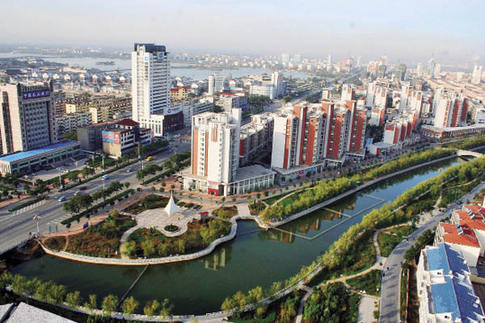Conservation and Development of the Grand Canal Shandong Section
Taking into consideration the recent history of the Shandong section, its application for world heritage might appear ambitious. Owing to historical vicissitudes, the once splendid Grand Canal underwent a gloomy decline. Urbanization and an expanding population resulted in the dumping of trash and construction of shacks along the ancient watercourse. In earlier times a famous cultural town in north China that rivaled even south China’s Hangzhou and Suzhou, historical records show that Zhangqiu Town of Liaocheng City was formerly graced with dozens of temples. Today, however, all have vanished without trace.
As the starting point of the Huitong Canal, the Linqing section is a vital node on the Grand Canal. Linqing’s abundant cultural heritages gave rise to the epithet “living cultural museum of the Ming and Qing dynasties.” After the general decline, however, the Linqing watercourse narrowed and fell into disuse. Certain spots along it degenerated into sewage outlets, and heritage sites sustained varying degrees of damage. The swarms of mosquitos that hovered over piles of miasmatic stinking garbage kept locals at a safe distance.
In addition to these difficulties, the Shandong section also had to deal with the fundamental issues of heritage and cultural protection, water transport, water conservancy and management, as well as local development projects. Taking into account problems associated with its choked reaches north of Jining’s Liangshan County, the Shandong section had the most onerous task of all others in accomplishing the environmental management necessary for its world heritage application. But the fact is that prior to the application a number of cities in Shandong had already embarked on Grand Canal conservation projects. After the application, various regions then set about the arduous and detailed work of clearance, regulation, restoration, and dredging.
To complete the work necessary for the Shandong section’s application, the CPC provincial committee and government established a strong leadership and working mechanism, signing liability compacts with the five cities along it. The provincial government published the Conservation Plan of the Shandong Section of the Grand Canal Heritage and also promulgated and implemented the Measures for the Protection and Management of the Shandong Section of the Grand Canal Heritage. China’s first provincial-level regulation on protecting the Grand Canal, it makes clear that within the protection domain and construction control area, such behavior as earth excavation and sewage disposal that damages the Shandong section constitutes cultural relic destruction – a civil or even criminal liability according to law.
 |
|
Vista of the Grand Canal at Liaocheng. |
Local governments have also carried out a number of provincial-level and city-level Grand Canal heritage conservation programs. These and other major heritage site conservation schemes have formed a comprehensive and instructive protection system that has been incorporated into local economic and social development plans as well as urban and rural planning.
The Grand Canal application for World Heritage augurs an immense conservation project that will construct eco-cities and beautiful villages, hence promoting rural tourism and bringing inestimable benefits to local residents. Since making the application, Shandong governments at all levels have invested around RMB one billion in the project, including RMB 500 million from national support, and RMB 100 million from a special provincial finance fund. These measures have ensured successful completion of the work entailed in the application. In addition to large-scale maintenance work on the Grand Canal, local governments have also undertaken beautification of the surrounding environment and resettlement of villagers.
Greenery now abounds along the canal’s zigzagging Dezhou section. Composed of the Wei Canal and South Canal, the entire section is 141 kilometers long and features a number of spots of cultural interest. They include the Tomb of King Sulu, the Dezhou Warehouse and Wharf, the Song Dynasty kiln site, and the Daguanying Mosque. The original canal landscape, the ancient but still operational warehouse, and the distinctive Tomb of King Sulu as well as the nearby ancient villages originally built to guard the tomb are the Dezhou section’s three precious remnants from earlier times. They embody the canal’s original look and economic and cultural functions. Since making the application the city has enhanced heritage conservation and environmental management and carried out protective development of the original landscape. Development has enabled people who formerly lived in shacks along the canal to move into new storied houses. An estimated five million people have benefited from the canal’s conservation since its application for World Heritage.
